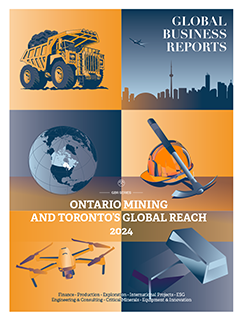Ontario's Talent Drought: Mining staying afloat in a shallow labor pool
RELATED PUBLICATION
ARTICLES FROM THIS PUBLICATION
Ontario's Talent Drought

Image courtesy of IAMGOLD
In September 2023, the Canadian Institute of Mining, Metallurgy and Petroleum (CIM) Toronto branch held a panel discussing how Canada could achieve the enormous increase in critical mineral production required for the green energy transition. One major question remained unanswered: Who is going to build these critical minerals mines?
The number of mining and mineral engineering graduates dropped by a third between 2016 and 2020 in Canada, according to Statistics Canada. Many other jurisdictions, like the UK and Colorado, reported similar drops in enrollment in mining-related degrees. This waning interest in mining and earth sciences from students poses a serious threat to the success of Ontario’s Critical Mineral Strategy, and by extension, to Canada’s net-zero plans. “The youth of today are not as interested in mining as a profession, which is truly unfortunate as there are great opportunities,” said Frank Galati, managing partner at the Bedford Group TRANSEARCH, an executive search and professional services firm catering to the Canadian mining sector.
Firms like Bedford Group TRANSEARCH have been hard at work trying to fill the glut of vacant positions in the mining sector. Since the pandemic, the percentage of job openings that remain unfilled has doubled. By the third quarter of 2022, there was only one job-seeker for every five job openings in mining and quarrying, according to the Canadian Mining Industry Human Resources Council.
The talent shortage extends beyond just university graduates: “Besides specialized skills, there is a shortage of truck drivers and general laborers. Surprisingly, masons and bricklayers are very sought after, with a notable gap in apprenticeships for this crucial trade,” said Steve Gravel, manager, Centre for Smart Mining at Cambrian College.
Unlike most North American universities and colleges, Cambrian has been experiencing record-high enrollment in many of its mining-related courses, due in part to the college’s ambition to look far from home for fresh talent: “Immigration is a key element in our comprehensive solution, tapping into students from existing mining jurisdictions abroad. This targeted approach ensures our graduates, even if new to Canada, bring valuable industry context, reducing the learning curve.”
Recruitment strategies like Cambrian’s are made possible by the Ontario government's pro-immigration stance. The province welcomed 45% of all new permanent residents in Canada from 2016-2021, with Toronto seeing the most settlers of any Canadian city by far. “We have several existing programs to attract and retain talent. Namely, the Ontario Immigrant Nominee Program and the Indigenous Workplace Development Program are making a difference,” said George Pirie, Ontario’s Minister of Mines.
Market volatility, mining’s reputation as a ‘dirty’ industry, and the remoteness and tough living conditions at many mining camps are just some of the factors driving young graduates away from the industry. “Improving facilities on site, improving rotation, and labeling mining companies as innovators will help to lessen the labor shortage in the years to come,” continued Galati.
A recent survey of young people by the Canadian Mining Industry Human Resources Council found that 70% said they “definitely” or “probably would not” work in the mining sector, making it even less popular than the Oil & Gas sector at 67%. In addition to this, the Covid pandemic substantially increased work from home in Canada and many industrialized countries. In January 2021, 32% of Canadians worked most of their hours from home, compared with 4% in 2016, according to Statistics Canada. Attracting young people to Ontario’s northern mining towns and away from the southern population centers in and around the Greater Toronto Area (GTA) continues to be a challenge. This has impacted firms like TBT Engineering, an engineering consultancy based in Thunder Bay, to the point where they have had to take significant measures to address the issue: “The difficulty in recruiting skilled professionals, especially from major urban centers in Canada, is compounded by the remote nature of our region. To overcome this hurdle, we are strategically opening an office in southern Ontario, in Collingwood,” shared Liana Frenette, CEO of TBT Engineering.
For skills that overlap with other industries, such as electrical engineering, the problem is exacerbated by young talent being drawn into Crown corporations. In some fields, it is notoriously difficult to draw talent back into the private sector. “Competition for talent extends to government entities actively recruiting individuals with engineering expertise, creating a situation where the industry competes with the government for the same limited pool. This challenge permeates every aspect of the industry, affecting operators who draw personnel from consultancies to address staffing needs,” said Chris Dougherty, president and chairman, Nordmin Engineering.
The shortage of talent within Ontario’s mining industry extends beyond engineers and geologists to the tradespeople employed by service providers and contractors. Ryan Whissell, general operations manager at Patrick Sprack Limited (PSL), a Northern Ontario-based HVAC service company, shared how this has impacted PSL: “We have had to turn down work in the past year due to the lack of skilled trades. Particularly in the last 18 months, it has been difficult to find talent in the wide range of skilled trades we are hiring for. This is a problem being felt across our entire industry.”
Making the industry more inclusive to attract a more diverse range of people might alleviate the ongoing labor shortage. “Companies should push themselves in the small things that can signal that they want their mine to be a comfortable place for a wide range of people and their families,” suggested Heather Cheeseman, partner and national mining leader at KPMG in Canada.
Industry figures often comment on mining and the earth sciences being underrepresented in Canada’s school curriculums, which they believe is contributing to the talent crunch. “The challenge we face is to attract youth into Earth Sciences, and we can only do this by dispelling misconceptions about the mining industry. Despite being a high-tech and clean sector with excellent employment prospects, there is a persistent belief that the industry is low-tech and polluting,” said Ross Sherlock, director of MERC and Metal Earth, chair in exploration targeting, Laurentian University.
Cognizant of this, industry organizations like MineConnect have been engaging with Ontario’s youth to elevate mining in schools across the province. “I show students what a mine looks like, the growing diversity in the industry, and the possibilities in non-traditional mining jobs— in drones, technology, and community engagement, for example,” said Marla Tremblay, executive director, MineConnect.
In approaching school-aged pupils, Ontario’s mining industry has an opportunity to showcase the role it will play in the energy transition through the development of the critical minerals needed for EVs, batteries, and renewables. Charlotte Gibson, associate head of the Robert M. Buchan department of mining at Queen’s University shared her observations of her recent cohorts: “An emerging theme among students is their interest in the energy transition and critical minerals. The increased awareness of environmental issues and the importance of critical minerals in the energy transition has influenced some students to see that mining can positively contribute to global challenges.”
With mine development taking upwards of 15 years in some cases, and an ever-dwindling supply of skilled professionals, the clock is ticking for Ontario’s mining sector to deliver the minerals the world needs to decarbonize.












